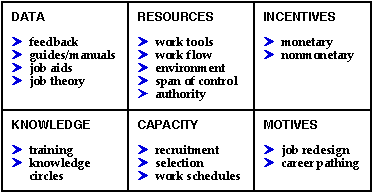![]()
![]()
Performance improvement efforts can be best achieved when organizational
policy supports it. It's often the manager's job to organization and direct
efforts to improve quality and productivity. Using a systematic approach
ensures that limited resources are directed where improvement is going to
be valued the most.
James & Associates utilizes a systematic approach that involves three
basic steps:
![]() Develop a MODEL of the current process.
Develop a MODEL of the current process.
![]() Take some MEASURES to determine if there is opportunity to improve.
Take some MEASURES to determine if there is opportunity to improve.
![]() Develop and implement METHODS of performance improvement.
Develop and implement METHODS of performance improvement.
The models, measures and methods approach to performance
improvement works well on a project basis (in an individual or team environment).
Performance improvment efforts begin with a clear understanding of the
process or organization being examined. This model:
![]() identifies inputs and primary outputs (products/services),
identifies inputs and primary outputs (products/services),
![]() identifies customers and suppliers,
identifies customers and suppliers,
![]() defines and documents the process,
defines and documents the process,
![]() defines customer and supplier expectations.
defines customer and supplier expectations.
A process or organizational model gives you the framework to evaluate existing
performance and identify opportunities for improvement. Without this model,
improvement efforts can be misdirected resulting in lost time, money and
personnel resources. After all, quality and productivity may be staring
you right in the face but you would never know it without a process or organizational
model.
This model usually takes the form of an organization
map and/or a cross-functional work flow diagram
(see examples).
The next step is to determine how well customer and supplier expectations
are being met (as defined by your process model). This is done through formal
measurement and by looking at other obvious performance cues. The purpose
of this evaluation is to identify opportunities for improvement. Then the
most valuable opportunities can be addressed with appropriate methods of
improvement.
In order to measure a process you need to design the measurement system
and collect the data. Then you can compare existing performance to expected
performance and determine the value of closing the gap between the two;
summarizing your findings in an Improvement Value Summary
Table (see example). Packaging the results (i.e.,
converting the data into useful information through the use of charts &
graphs) will help you further pinpoint the source of the performance improvement
opportunity.
The last step is to develop and implement performance improvement methods
that will capitalize on your identified opportunities. There are many tools
and techniques available and selecting the correct one(s) is by no means
an easy task. What works well in one situation (or work group) might not
work well in another. You need a systematic framework to sort through all
of the options.

James & Associates uses an Issue/Opportunity Summary to document ideas and recommendations for improving a process (see example).